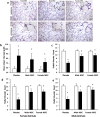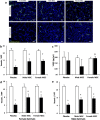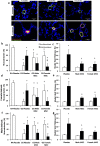The Effect of Gender on Mesenchymal Stem Cell (MSC) Efficacy in Neonatal Hyperoxia-Induced Lung Injury
- PMID: 27711256
- PMCID: PMC5053475
- DOI: 10.1371/journal.pone.0164269
The Effect of Gender on Mesenchymal Stem Cell (MSC) Efficacy in Neonatal Hyperoxia-Induced Lung Injury
Abstract
Background: Mesenchymal stem cells (MSC) improve alveolar and vascular structures in experimental models of bronchopulmonary dysplasia (BPD). Female MSC secrete more anti-inflammatory and pro-angiogenic factors as compared to male MSC. Whether the therapeutic efficacy of MSC in attenuating lung injury in an experimental model of BPD is influenced by the sex of the donor MSC or recipient is unknown. Here we tested the hypothesis that female MSC would have greater lung regenerative properties than male MSC in experimental BPD and this benefit would be more evident in males.
Objective: To determine whether intra-tracheal (IT) administration of female MSC to neonatal rats with experimental BPD has more beneficial reparative effects as compared to IT male MSC.
Methods: Newborn Sprague-Dawley rats exposed to normoxia (RA) or hyperoxia (85% O2) from postnatal day (P) 2- P21 were randomly assigned to receive male or female IT bone marrow (BM)-derived green fluorescent protein (GFP+) MSC (1 x 106 cells/50 μl), or Placebo on P7. Pulmonary hypertension (PH), vascular remodeling, alveolarization, and angiogenesis were assessed at P21. PH was determined by measuring right ventricular systolic pressure (RVSP) and pulmonary vascular remodeling was evaluated by quantifying the percentage of muscularized peripheral pulmonary vessels. Alveolarization was evaluated by measuring mean linear intercept (MLI) and radial alveolar count (RAC). Angiogenesis was determined by measuring vascular density. Data are expressed as mean ± SD, and analyzed by ANOVA.
Results: There were no significant differences in the RA groups. Exposure to hyperoxia resulted in a decrease in vascular density and RAC, with a significant increase in MLI, RVSP, and the percentage of partially and fully muscularized pulmonary arterioles. Administration of both male and female MSC significantly improved vascular density, alveolarization, RVSP, percent of muscularized vessels and alveolarization. Interestingly, the improvement in PH and vascular remodeling was more robust in the hyperoxic rodents who received MSC from female donors. In keeping with our hypothesis, male animals receiving female MSC, had a greater improvement in vascular remodeling. This was accompanied by a more significant decrease in lung pro-inflammatory markers and a larger increase in anti-inflammatory and pro-angiogenic markers in male rodents that received female MSC. There were no significant differences in MSC engraftment among groups.
Conclusions: Female BM-derived MSC have greater therapeutic efficacy than male MSC in reducing neonatal hyperoxia-induced lung inflammation and vascular remodeling. Furthermore, the beneficial effects of female MSC were more pronounced in male animals. Together, these findings suggest that female MSC maybe the most potent BM-derived MSC population for lung repair in severe BPD complicated by PH.
Conflict of interest statement
The authors have declared that no competing interests exist.
Figures






Similar articles
-
Comparative Effects of Bone Marrow-derived Versus Umbilical Cord Tissue Mesenchymal Stem Cells in an Experimental Model of Bronchopulmonary Dysplasia.Stem Cells Transl Med. 2022 Mar 17;11(2):189-199. doi: 10.1093/stcltm/szab011. Stem Cells Transl Med. 2022. PMID: 35298658 Free PMC article.
-
Stromal derived factor-1 mediates the lung regenerative effects of mesenchymal stem cells in a rodent model of bronchopulmonary dysplasia.Respir Res. 2017 Jul 12;18(1):137. doi: 10.1186/s12931-017-0620-z. Respir Res. 2017. PMID: 28701189 Free PMC article.
-
Intra-tracheal administration of a naked plasmid expressing stromal derived factor-1 improves lung structure in rodents with experimental bronchopulmonary dysplasia.Respir Res. 2019 Nov 12;20(1):255. doi: 10.1186/s12931-019-1224-6. Respir Res. 2019. PMID: 31718614 Free PMC article.
-
Mesenchymal Stromal Cell Therapy in Bronchopulmonary Dysplasia: Systematic Review and Meta-Analysis of Preclinical Studies.Stem Cells Transl Med. 2017 Dec;6(12):2079-2093. doi: 10.1002/sctm.17-0126. Epub 2017 Oct 17. Stem Cells Transl Med. 2017. PMID: 29045045 Free PMC article.
-
Mesenchymal stem cells for the prevention of bronchopulmonary dysplasia.Pediatr Int. 2019 Oct;61(10):945-950. doi: 10.1111/ped.14001. Epub 2019 Oct 14. Pediatr Int. 2019. PMID: 31487104 Review.
Cited by
-
Epigenetic mechanisms regulate sex differences in cardiac reparative functions of bone marrow progenitor cells.NPJ Regen Med. 2024 Apr 29;9(1):17. doi: 10.1038/s41536-024-00362-2. NPJ Regen Med. 2024. PMID: 38684697 Free PMC article.
-
Epigenetic regulation of sex dimorphism in cardiovascular health.Can J Physiol Pharmacol. 2024 Sep 1;102(9):498-510. doi: 10.1139/cjpp-2023-0406. Epub 2024 Mar 1. Can J Physiol Pharmacol. 2024. PMID: 38427976 Free PMC article. Review.
-
Are all stem cells equal? Systematic review, evidence map, and meta-analyses of preclinical stem cell-based therapies for bronchopulmonary dysplasia.Stem Cells Transl Med. 2020 Feb;9(2):158-168. doi: 10.1002/sctm.19-0193. Epub 2019 Nov 20. Stem Cells Transl Med. 2020. PMID: 31746123 Free PMC article.
-
Sex-Related Differences of Weight Bearing and Non-Weight Bearing Muscle Properties.Muscles. 2023 Dec 15;2(4):400-412. doi: 10.3390/muscles2040031. Muscles. 2023. PMID: 40757535 Free PMC article.
-
Human mesenchymal stem cells ameliorate experimental pulmonary hypertension induced by maternal inflammation and neonatal hyperoxia in rats.Oncotarget. 2017 Jul 19;8(47):82366-82375. doi: 10.18632/oncotarget.19388. eCollection 2017 Oct 10. Oncotarget. 2017. PMID: 29137270 Free PMC article.
References
-
- Bhandari A, Bhandari V. “New” Bronchopulmonary Dysplasia: A Clinical Review. Clin Pulm Med. 2011;18(3):137–43 10.1097/CPM.0b013e318218a071 - DOI
MeSH terms
Substances
LinkOut - more resources
Full Text Sources
Other Literature Sources
Miscellaneous

